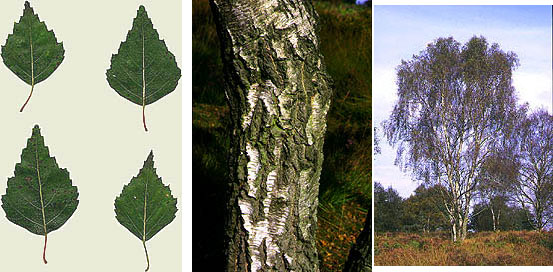The Trees at Keele
Silver Birch Betula pendula

Origin: a native tree in all parts of the UK, it is abundant on the light gravelly soils of heaths and on the shallow peat of hills and moorland.
Tree: in shape, young trees are rather upright and conical but they become more domed with age and the branches hang down in a pendulous manner (photo).
The bark is shiny red-brown when very young, almost like that of a cherry, becoming white with big black diamonds; often deeply fissured at the base.
The leaves are irregularly oval or diamond shape with the edges doubly toothed with the ends of the teeth curving towards the tip of the leaf. The base of the leaf is flat across the bottom or with straight sloping sides whereas in Downy Birch it is curved.
The twigs are hairless but have small resinous warts, which accounts for its other, less common, name of Warty Birch.
The fruits are long catkins which break up in the autumn to release copious quantities of wind-blown seed. Very attractive to seed-eating birds such as Redpolls and Siskins.
Uses: Birch timber grown in this country is only of use for plywood, veneers, turning into broom and tool handles etc. The twigs are used in besoms, steeplechase jumps etc.
Location : well-distributed over campus - the commonest birch.

